Chapter 4Negative Externalities
- 格式:ppt
- 大小:278.50 KB
- 文档页数:36
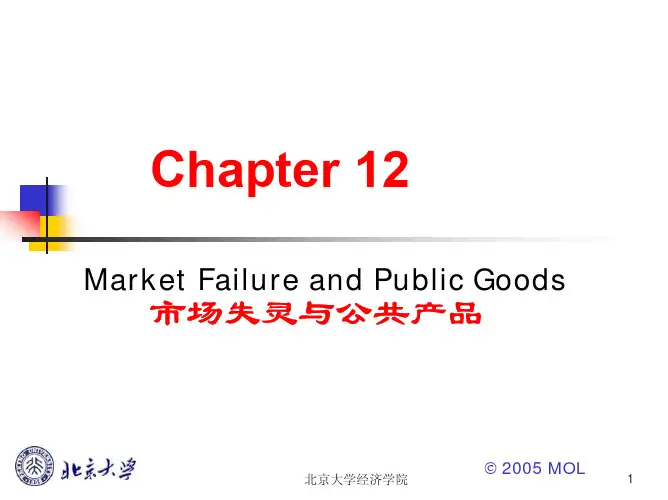

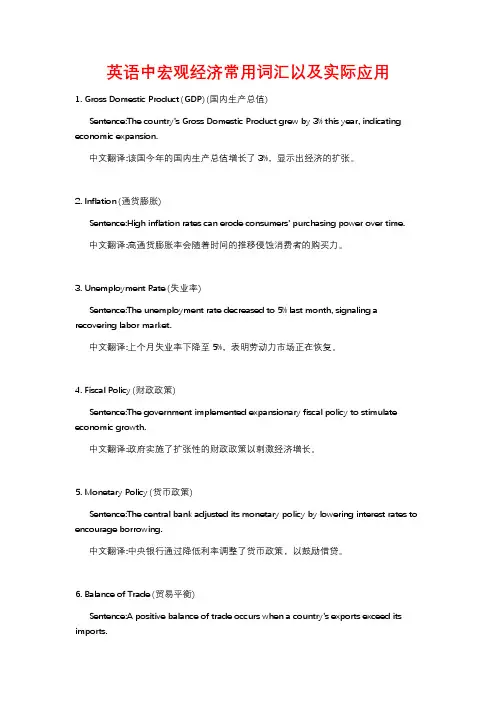
英语中宏观经济常用词汇以及实际应用1. Gross Domestic Product (GDP) (国内生产总值)Sentence:The country's Gross Domestic Product grew by 3% this year, indicating economic expansion.中文翻译:该国今年的国内生产总值增长了3%,显示出经济的扩张。
2. Inflation (通货膨胀)Sentence:High inflation rates can erode consumers' purchasing power over time.中文翻译:高通货膨胀率会随着时间的推移侵蚀消费者的购买力。
3. Unemployment Rate (失业率)Sentence:The unemployment rate decreased to 5% last month, signaling a recovering labor market.中文翻译:上个月失业率下降至5%,表明劳动力市场正在恢复。
4. Fiscal Policy (财政政策)Sentence:The government implemented expansionary fiscal policy to stimulate economic growth.中文翻译:政府实施了扩张性的财政政策以刺激经济增长。
5. Monetary Policy (货币政策)Sentence:The central bank adjusted its monetary policy by lowering interest rates to encourage borrowing.中文翻译:中央银行通过降低利率调整了货币政策,以鼓励借贷。
6. Balance of Trade (贸易平衡)Sentence:A positive balance of trade occurs when a country's exports exceed its imports.中文翻译:当一个国家的出口超过进口时,就会出现贸易平衡顺差。
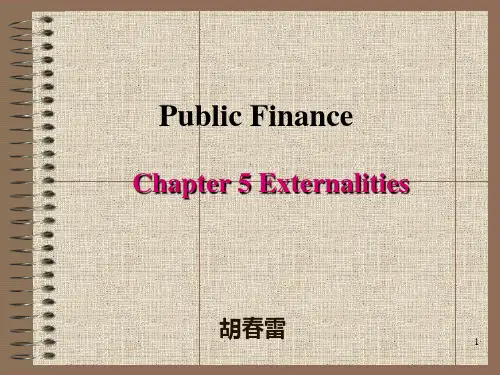
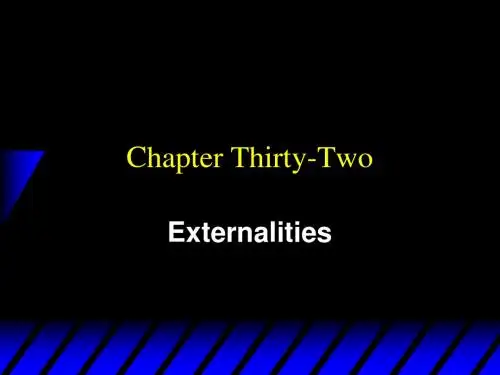
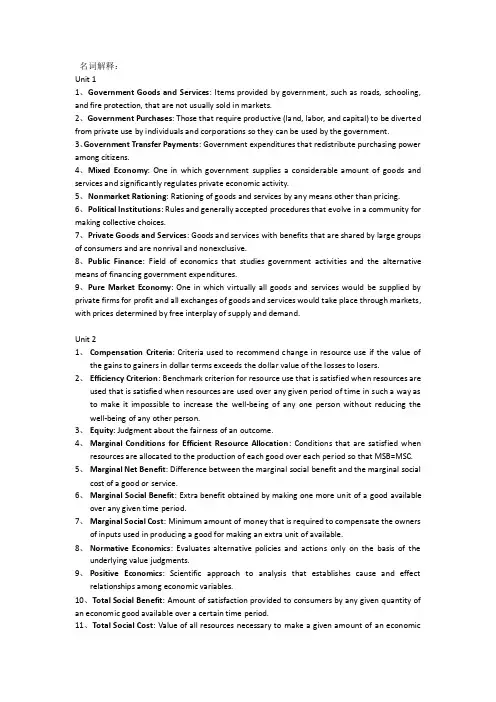
名词解释:Unit 11、Government Goods and Services: Items provided by government, such as roads, schooling, and fire protection, that are not usually sold in markets.2、Government Purchases: Those that require productive (land, labor, and capital) to be diverted from private use by individuals and corporations so they can be used by the government.3、Government Transfer Payments: Government expenditures that redistribute purchasing power among citizens.4、Mixed Economy: One in which government supplies a considerable amount of goods and services and significantly regulates private economic activity.5、Nonmarket Rationing: Rationing of goods and services by any means other than pricing.6、Political Institutions: Rules and generally accepted procedures that evolve in a community for making collective choices.7、Private Goods and Services: Goods and services with benefits that are shared by large groups of consumers and are nonrival and nonexclusive.8、Public Finance: Field of economics that studies government activities and the alternative means of financing government expenditures.9、Pure Market Economy: One in which virtually all goods and services would be supplied by private firms for profit and all exchanges of goods and services would take place through markets, with prices determined by free interplay of supply and demand.Unit 21、Compensation Criteria: Criteria used to recommend change in resource use if the value ofthe gains to gainers in dollar terms exceeds the dollar value of the losses to losers.2、Efficiency Criterion: Benchmark criterion for resource use that is satisfied when resources areused that is satisfied when resources are used over any given period of time in such a way as to make it impossible to increase the well-being of any one person without reducing the well-being of any other person.3、Equity: Judgment about the fairness of an outcome.4、Marginal Conditions for Efficient Resource Allocation: Conditions that are satisfied whenresources are allocated to the production of each good over each period so that MSB=MSC.5、Marginal Net Benefit: Difference between the marginal social benefit and the marginal socialcost of a good or service.6、Marginal Social Benefit: Extra benefit obtained by making one more unit of a good availableover any given time period.7、Marginal Social Cost: Minimum amount of money that is required to compensate the ownersof inputs used in producing a good for making an extra unit of available.8、Normative Economics: Evaluates alternative policies and actions only on the basis of theunderlying value judgments.9、Positive Economics: Scientific approach to analysis that establishes cause and effectrelationships among economic variables.10、Total Social Benefit: Amount of satisfaction provided to consumers by any given quantity of an economic good available over a certain time period.11、Total Social Cost: Value of all resources necessary to make a given amount of an economicgood available over a given time period.12、Utility-Possibility Curve: Curve that illustrates efficient combinations of well-being between two individuals.Unit 31、Coase Theorem: States that governments, by merely establishing the rights o use resources,can internalize externalities when transaction coats of bargaining are zero.2、Command-and-Control Regulation: A system of rules established by government authoritiesthat requires all emitters of wastes to meet strict standards and requires the use of specific pollution control devices.3、Corrective Subsidy: Subsidy designed to adjust marginal private benefit in such a way as tointernalize a positive externality.4、Corrective Tax: Tax designed to adjust the marginal private cost of a good or service in such away as to internalize a negative externality.5、Externalities: Costs or benefits of market transactions not reflected in prices.6、General Theory of Second Best: States that when two opposing factors contribute toefficiency losses, they can offset one another’s distortions.7、Internalization of an Externality: Occurs when the marginal private benefit or cost of goodsand services is adjusted so that the users consider the actual marginal social benefit or cost of their decisions.8、Marginal External Benefit (MEB): Benefit of additional output accruing to parties other thanbuyers or sellers.9、Marginal External Cost (MEC): Extra cost to third parties other than buyers or sellers of agood resulting from production of another unit of a good or service.10、Marginal Private Benefit (MPB): Marginal benefit that consumers base their decisions on.11、Marginal Private Cost (MPC): Marginal cost that producers base their decisions on.12、Negative Externalities: Also called external costs, costs to third parties other than the buyers or the sellers of an item not reflected in the market price.13、Pollution Abatement: Reduction in pollution that results from reduced emissions.14、Pollution Rights: Transferable permits to emit a certain amount of particular wastes into the atmosphere or water per year.15、Positive Externalities: Benefits to third parties other than the buyers or the sellers of a good or service not reflected in prices.16、Small-Number Externalities: Externalities involving few enough parties so that the transaction costs of bargaining to internalize the externalities are negligible.17、Transactions Costs: Value of the time, effort, and cash outlay involved in locating someone to trade with, negotiating terms of trade, drawing contracts, and assuming risks associated with the contracts.Unit 41、Congestible Public Goods: Those for which crowding or congestion reduces the benefits toexisting consumers when more consumers are accommodated.2、Free Rider: Problem that exists when people seek to enjoy the benefits of a benefit of apublic good without contributing anything to the cost of financing the amount madeavailable.3、Lindahl Equilibrium: Exists when the voluntary contribution per unit of the public good ofeach member of the community equals his or her marginal benefit of the public good at the efficient level of output.4、Lindahl Prices: Equilibrium contributions per unit of the public good that equal the marginalbenefit received by each consumer.5、Nonexclusion: Property of a pure public good that exists when it is infeasible to price units ofa good in a way that prevents those who do not pay from enjoying its benefits.6、Nonrival in Consumption: Property of a pure public good that allows a given quantity of thegood to be consumed by an entire population.7、Price-Excludable Public Goods: Goods with benefits that can be priced.8、Private Goods: Items such as food and clothing that are usually rival in consumption and aremade available for sale in markets because people easily can be excluded from benefits if they do not pay.9、Public Goods: Goods with benefits that are shared by large groups of consumers and arenonrival and nonexclusive.10、Pure Private Good: Good that provides benefit only to the person who acquires them and not to anyone else after producers receive compensation for the full opportunity costs of production.11、Pure Public Good: Good that is nonrival in consumption for an entire population of consumers and has nonexclusionary benefit.Unit 51、Arrow’s Impossibility Theorem: States that it is impossible for public choices to meet a set ofconditions for rationality when some voters have multiple-peaked preferences.2、Bureaucracy: Group of agencies in charge of implementing collective choices made throughpolitical institutions.3、Constitutions: The generally accepted set of rules by which decisions are made in a society.4、Implicit Logrolling: Occurs when political interests succeed in pairing on the same ballot orthe same bill two (or more) issues of strong interest to divergent groups.5、Logrolling: Trading of votes on issues of great interest to voters.6、Median Voter: One whose most-preferred outcome is the median of the most-preferredoutcomes of all those voting.7、Median Voter Rule: Political equilibrium is the median most-preferred outcome of all voterswhen collective choices are made under majority rule and all voters have single-peaked preferences.8、Most-Preferred Political Outcome: Quantity of the government-supplied good correspondingto the point at which the person’s tax share is equal to his marginal benefit of the good.9、Multiple-Peaked Preferences: Imply that persons who move away from their most-preferredalternative become worse off at first but eventually become better off as the movement continues in the same direction.10、Political Equilibrium: Agreement on the level of production of one or more public goods, given the specified rule for making the collective choice and the distribution of tax shares among individuals.11、Political Externalities: Losses in well-being that occur when voters do not obtain theirmost-preferred outcomes, given their tax shares.12、Political Parties: Organizations of individuals with similar ideas on the role of government and other issues.13、Political Transactions Costs: Measures of the value of time, effort, and other resources expended to reach and enforce a collective agreement.14、Public Choice: A choice made through political interaction of many persons according to established rules.15、Rational Ignorance: Voter ignorance of either the benefits or costs of government activity stemming from the positive cost of attaining information.16、Simple Majority Rule: Rule under which a proposal is approved if it receives more than half the votes cast in an election.17、Single-Peaked Preferences: Imply that individuals behave as if a unique most-preferred outcome is available, and that the individuals are always made worse off when they move away from the outcome.18、Special-Interest Groups: Lobbies that seek to increase government expenditures that benefit their constituents.19、Tax Shares: Preannounced shares of the unit costs of a public good to be provided by government assigned to citizens voting in an election.。
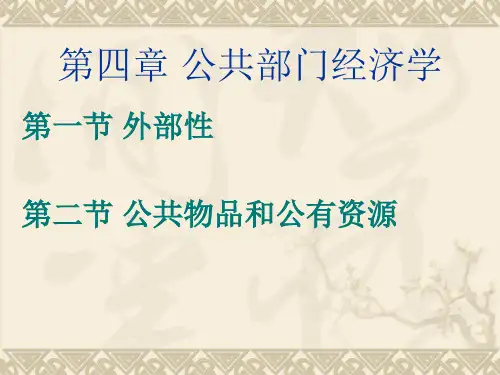
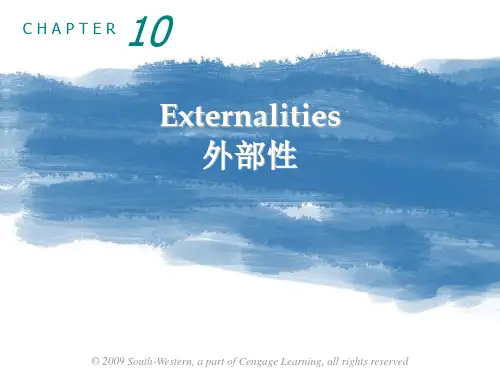
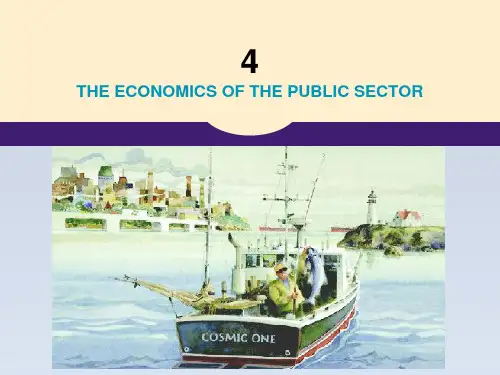
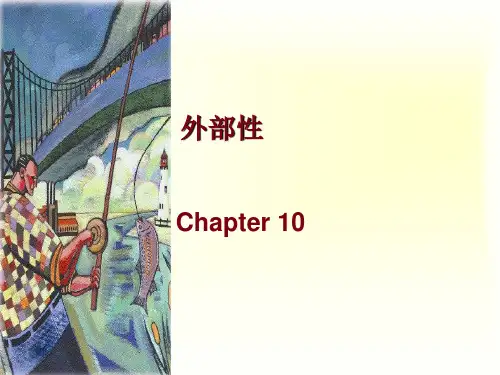
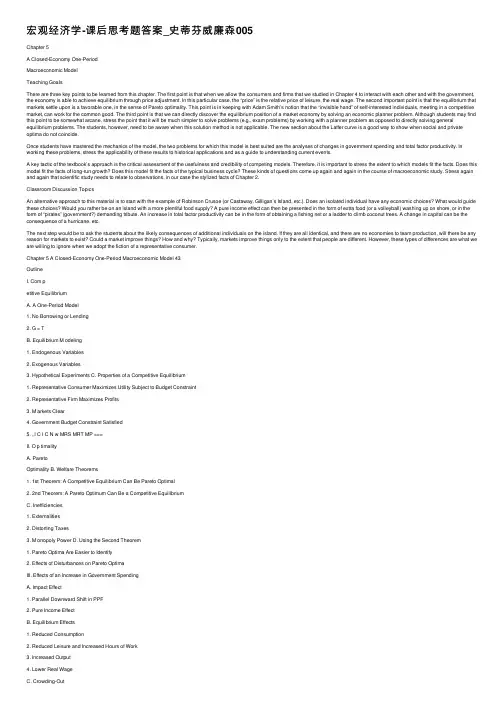
宏观经济学-课后思考题答案_史蒂芬威廉森005Chapter 5A Closed-Economy One-PeriodMacroeconomic ModelTeaching GoalsThere are three key points to be learned from this chapter. The first point is that when we allow the consumers and firms that we studied in Chapter 4 to interact with each other and with the government, the economy is able to achieve equilibrium through price adjustment. In this particular case, the “price” is the relative price of leisure, the real wage. The second important point is that the equilibrium that markets settle upon is a favorable one, in the sense of Pareto optimality. This point is in keeping with Adam Smith’s notion that the “invisible hand” of self-interested individuals, meeting in a competitive market, can work for the common good. The third point is that we can directly discover the equilibrium position of a market economy by solving an economic planner problem. Although students may find this point to be somewhat arcane, stress the point that it will be much simpler to solve problems (e.g., exam problems) by working with a planner problem as opposed to directly solving general equilibrium problems. The students, however, need to be aware when this solution method is not applicable. The new section about the Laffer curve is a good way to show when social and private optima do not coincide.Once students have mastered the mechanics of the model, the two problems for which this model is best suited are the analyses of changes in government spending and total factor productivity. In working these problems, stress the applicability of these results to historical applications and as a guide to understanding current events.A key tactic of the textbook’s approach is the critical assessment of the usefulness and credibility of competing models. Therefore, it is important to stress the extent to which models fit the facts. Does this model fit the facts of long-run growth? Does this model fit the facts of the typical business cycle? These kinds of questions come up again and again in the course of macroeconomic study. Stress again and again that scientific study needs to relate to observations, in our case the stylized facts of Chapter 2.Classroom Discussion TopicsAn alternative approach to this material is to start with the example of Robinson Crusoe (or Castaway, Gilligan’s Island, etc.). Does an isolated individual have any economic choices? What would guide these choices? Would you rather be on an island with a more plentiful food supply? A pure income effect can then be presented in the form of extra food (or a volleyball) washing up on shore, or in the form of “pirates” (government?) demanding tribute. An increase in total factor productivity can be in the form of obtaining a fishing net or a ladder to climb coconut trees. A change in capital can be the consequence of a hurricane, etc.The next step would be to ask the students about the likely consequences of additional individuals on the island. If they are all identical, and there are no economies to team production, will there be any reason for markets to exist? Could a market improve things? How and why? Typically, markets improve things only to the extent that people are different. However, these types of differences are what we are willing to ignore when we adopt the fiction of a representative consumer.Chapter 5 A Closed-Economy One-Period Macroeconomic Model 43OutlineI. Com petitive EquilibriumA. A One-Period Model1. No Borrowing or Lending2. G = TB. Equilibrium M odeling1. Endogenous Variables2. Exogenous Variables3. Hypothetical Experiments C. Properties of a Competitive Equilibrium1. Representative Consumer Maximizes Utility Subject to Budget Constraint2. Representative Firm Maximizes Profits3. M arkets Clear4. Government Budget Constraint Satisfied5. ,,l C l C N w MRS MRT MP ===II. O p timalityA. ParetoOptimality B. Welfare Theorems1. 1st Theorem: A Competitive Equilibrium Can Be Pareto Optimal2. 2nd Theorem: A Pareto Optimum Can Be a Competitive EquilibriumC. Inefficiencies1. Externalities2. Distorting Taxes3. M onopoly Power D. Using the Second Theorem1. Pareto Optima Are Easier to Identify2. Effects of Disturbances on Pareto OptimaIII. Effects of an Increase in Government SpendingA. Impact Effect1. Parallel Downward Shift in PPF2. Pure Income EffectB. Equilibrium Effects1. Reduced Consumption2. Reduced Leisure and Increased Hours of Work3. Increased Output4. Lower Real WageC. Crowding-OutD. Government Spending a Source of Business Cycles?1. Government Spending Shocks Wrongly Predict Countercyclical Consumption2. Government Spending Shocks Wrongly Predict Countercyclical Real Wages44 Williamson ? Macroeconomics, Third EditionIV. Effects of an Increase in Total Factor ProductivityA. Impact Effect1. Upward Shift in PPF2. Steeper PPF3. Income and Substitution EffectsB. Equilibrium Effects1. Increased Consumption2. Leisure and Hours Worked May Rise or Fall3. Increased Output4. Higher Real WageC. Productivity and Long-Run Growth1. Consumption Grows over Time2. Hours Worked Remain about Constant3. Output Increases over Time4. Real Wages Rise over TimeD. Productivity as Source of Business Cycles?1. Consumption Is Procyclical2. Cyclical Properties of Hours Workeda. Procyclical Hours Worked Is a Business Cycle Factb. Need Strong Substitution Effect to Predict Procyclical Hoursc. Intertemporal Substitution of Leisure3. Increased Output Defines the Cycle4. Procyclical Real Wage RateV. Income Tax Revenue and the Laffer CurveA. Tax Revenue1. The Tax Base Depends on the Proportional Tax Rate2. The Laffer Curve Measures Tax Revenue as a Function of the Tax Rate3. Unless the Tax Rate Is Optimal, Two Tax Rates Yield the Same Tax Revenue4. Supply-Side Economists Claim the U.S. Economy Is at the Bad Tax Rate5. Empirical Evidence Tends to Prove Supply-Side Economists WrongTextbook Question SolutionsQuestions for Review1. A closed economy is easier to work with. Opening the economy does not change most of theproperties of an economy. The closed economy is the correct model for the world as a whole.2. Government levies taxes and purchases consumption goods.3. In a one-period model, there can be no borrowing or lending. There is therefore no way to finance agovernment deficit.4. Endogenous variables: C, N s, N d, T, Y, and w.5. Exogenous variables: G, z, K.Chapter 5 A Closed-Economy One-Period Macroeconomic Model 456. The representative consumer chooses C and N s to maximize utility.The representative firm chooses N d to maximize profits.M arket-clearing: .s d N N N == Government budget constraint: T = G .7. The slope of the production possibilities frontier is equal to .N MP ? The slope of the productionpossibilities frontier is also identified as ,,l C MRT ? where ,l C MRT is identified as the marginal rate oftransformation between leisure and consumption.8. The competitive equilibrium is Pareto optimal because it lies at a tangency point between theproduction possibilities frontier and a representative consumer’s indifference curve.9. The first theorem: A competitive equilibrium can be Pareto optimal. This theorem assures us that thecompetitive equilibrium is a good outcome. The second theorem: A Pareto optimum is a competitive equilibrium. This theorem allows us to directly analyze Pareto optima with the assurance that these points are also competitive equilibriums. The second theorem is useful because Pareto Optima are often easier to work with than competitive equilibriums.10. Externalities, noncompetitive behavior, and distorting taxes.11. , ,, , and .G Y C N l w ↑?↑↓↑↓↓ 12. Government competes with the private sector in buying goods. An increase in government spendingimplies a negative wealth effect, which results in lower consumption.13. , , and .z Y C w ↑?↑↑↑ The sign of the effects on N and l are ambiguous.14. The substitution effect of an increase in z is that the representative consumer works more hours. Theincome effect of an increase in z is that the representative household works more hours. The sign of the net effect is ambiguous.15. A distorting tax makes that households equalize their marginal rate of substitution between leisureand consumption to the after tax wage, which is different from the before tax wage that firms equalize their marginal rate of transformation to. Thus, one cannot achieve the Pareto optimum where the same wage (before tax) is equal to both marginal rates above.16. The Laffer curve takes into account that higher proportional tax rates give incentives to households towork less. While tax revenue increases with the tax rate for a given tax base, that tax base is reduced by the tax rate.17. When the income tax rate falls, households are willing to supply additional labor more in suchquantities that the tax base increases more than what the tax rate decreases, thus increasing taxrevenue.46 Williamson ? Macroeconomics, Third EditionProblems1. Although we often think about the negative externalities of congestion and pollution in cities, theremay also be some positive externalities. A concentrated population is better able to support the arts and professional sports; cities typically have a greater variety of good restaurants, etc. Perhaps a more basic issue is that there may be some increasing returns to scale at low output levels that makeindustrial production more costly in small towns. There may also be externalities in production in being located close to other producers. One example would be the financial industry in financial centers like New York, London, Tokyo, etc. Another example would be large city medical centers that enhance coordination between primary physicians and specialists.One market test of whether productivity is higher in cities would be to look at the wages in cities versus the wages in smaller towns and rural areas. Wages are often higher in cities for individuals of comparable skills. Market efficiency suggests that the higher wages be reflective of a higher marginal product of labor, and that the higher wages compensate those choosing to live in cities for the negative externalities that they face.2. In a one period model, taxes must be exactly equal to government spending. A reduction in taxes istherefore equivalent to a reduction in government spending. The result is exactly opposite of the case of an increase in government spending that is presented in the text. A reduction in government spending induces a pure income effect that induces the consumer to consume more and work less. At lower employment, the equilibrium real wage is higher because the marginal product of labor rises when employment falls. Output falls, consumption rises, employment falls and the real wage rises.3. The only impact effect of this disturbance is to lower the capital stock. Therefore, the productionpossibility frontier shifts down and the marginal product of labor falls (PPF is flatter).(a) The reduction in the capital stock is depicted in the figure below. The economy starts at point Aon PPF1. The reduction in the capital stock shifts the production possibilities frontier to PPF2.Because PPF2 is flatter, there is a substitution effect that moves the consumer to point D. Theconsumer consumes less of the consumption good and consumes more leisure. Less leisure also means that the consumer works more. Because the production possibilities frontier shifts down, there is also an income effect. The income effect implies less consumption and less leisure (more work). On net, consumption must fall, but leisure could decrease, remain the same, or increase, depending on the relative strengths of the income and substitution effect. The real wage must also fall. To see this, we must remember that, in equilibrium, the real wage must equal the marginal rate of substitution. The substitution effect implies a lower marginal rate of substitution. The income effect is a parallel shift in the production possibilities frontier. As the income effect increases the amount of employment, marginal product of labor must fall from point D topoint B. This reinforces the reduction in the marginal rate of substitution from point A to point D.Chapter 5 A Closed-Economy One-Period Macroeconomic Model 47(b) Changes in the capital stock are not likely candidates for the source of the typical business cycle.While it is easy to construct examples of precipitous declines in capital, it is more difficult toimagine sudden increases in the capital stock. The capital stock usually trends upward, and thisupward trend is important for economic growth. However, the amount of new capital generatedby a higher level of investment over the course of a few quarters, of a few years, is very small in comparison to the existing stock of capital. On the other hand, a natural disaster that decreases the stock of capital implies lower output and consumption, and also implies lower real wages,which are all features of the typical business cycle contraction.4. Government Productivity. First consider the benchmark case in which 1,z= and there is no effect of changes in z on government activities. Now suppose that z increases. This case of an increase in z isdepicted in the figure below. The original production possibilities frontier is labeled PPF1 and thecompetitive equilibrium is at point A. If the increase in z only affects the economy through thechange in (,),zF K N then the new production possibilities frontier is PPF2. The diagram shows acase in which the income and substitution effects on leisure exactly cancel out, and the economy moves to point B. The equation for the production possibilities frontier is (,).C zF K h l T=?? In the benchmark case, T G= and so we have (,).C zF K h l G=?? For this problem, /T G z=, and so the production possibilities frontier is given by (,)/.C zF K h l G z=?? When 1,z= the two PPFs coincide. When z increases, the vertical intercept of the PPF increases by /.G zΔ Therefore, the newPPF is PPF3 in the figure below. The competitive equilibrium is at point C. There is an additionalincome effect that provides an additional increase in equilibrium consumption, and a reinforced income effect that tend to make leisure increase. Therefore, relative to the benchmark case, there is a larger increase in consumption, and either a smaller decrease in leisure or a larger increase in leisure.48 Williamson ? Macroeconomics, Third Edition5. Change in preferences.(a) At the margin, the consumer decides that leisure is more preferred to consumption. That is, theconsumer now requires a bigger increase in consumption to willingly work more (consume lessleisure). In more intuitive language, the consumer is lazier.(b) To work out the effects of this change in tastes, we refer to the figure below. The productionpossibility frontier in this example is unchanged. The consumer now picks a new point at which one of the flatter indifference curves is tangent to the production possibilities frontier. That is,equilibrium will shift from point A to point B. Consumption falls and leisure rises. Therefore, the consumer works less and produces less. Because employment has fallen, it also must be the case that the real wage increases.(c) This disturbance, which some might characterize as a contagious outbreak of laziness, wouldhave the appearance of a recession, as output and employment both fall. The consequentreduction in consumption is also consistent with a typical recession. However, in this case thereal wage would rise, which is inconsistent with the business cycle facts. Therefore, this type ofpreference change is not a cause of recessions.Chapter 5 A Closed-Economy One-Period Macroeconomic Model 496. Production-enhancing aspects of government spending.(a) The increase in government spending in this example has two separate effects on the productionpossibilities frontier. First, the increase in government spending from G1 to G2implies a paralleldownward shift in the production possibilities frontier. Second, the productive nature of government spending is equivalent to an increase in total factor productivity that shifts the production possibilities frontier upward and increases its slope. The figure below draws theoriginal production possibilities frontier as PPF1 and the new production possibilities frontier asPPF2. If the production-enhancing aspects of the increase in government spending are largeenough, representative consumer utility could rise, as in this figure.(b) There are three effects at work in this example. First, there is a negative income effect from theincrease in taxes needed to pay for the increased government spending. This effect tends to lower both consumption and leisure. Second, there is a substitution effect due to the productive effect of the increase in G, which is drawn as the movement from point A to point D. This effect tends to increase both consumption and leisure. Third, there is a positive income effect from theincrease in G on productivity. This effect tends to increase both consumption and leisure. In the figure above, the movement from point D to point B is the net effect of the two income effects. In general, consumption may rise or fall, and leisure may rise or fall. The overall effect on output is the same as in any increase in total factor productivity. Output surely rises.50 Williamson ? Macroeconomics, Third Edition7. The fact that government spending make firms more productive is similar to adding G to theproduction function. There are now two effects to an increase in government expenses: the standard crowding out of consumption, and now also an efficiency effect on production.(a) The figure below illustrates a particular situation where the welfare of the household is improved,as illustrated by a shift to the north-east of the indifference curve. The equilibrium shifts fromA toB as the PPF is lowered by the additional government expenses but is also getting steeperthanks to the same government expenses.(b) From previous results, we know that output increases with the increase in government expenses.This is now reinforced as G increases production efficiency. Regarding consumption and leisure, without this new effect, we obtained that an increase in G lead to a negative income effect andthus to decreases in both consumption and leisure. But as the real wage went down, there wasalso a substitution effect leading to an additional decrease in consumption and increase in leisure.The new effect on the production function adds opposite effects: a positive income effect and awage increase, thus possibly reversing, or not, anything that was concluded without the impact ofG on production.Chapter 5 A Closed-Economy One-Period Macroeconomic Model 51 8. We need to analyze each case separately. Start with the good equilibrium. As government expensesincrease, more tax revenue needs to be raised, and thus the tax rate needs to be increased. As shown in the figure below, this tilts down the linear PPF. The new equilibrium leads to a lower indifference curve. This leads to a negative income effect and a lower wage (remember, it is z(1 ? t)), thus a substitution effect. The income effect lowers consumption and leisure, the substitution effectdecreases consumption and increases leisure. All in all, consumption is lower and leisure is higher, as we know that the substitution effect dominates the income effect. This means that the labor supplyis reduced, and thus equilibrium labor and output.The story is different in the bad equilibrium. To increase tax revenue, one needs to reduce the tax rate. Then all the changes discussed above are exactly in the opposite direction.9. We know from previous analysis that an improvement in total factor productivity pushes up the PPF,and thus leads to an increase in consumption, a decrease in leisure, and thus an increase in thequantity of labor supplied. This increases the tax base, and thus allows to reduce the tax rate toachieve the same tax revenue, or in other words, it pushes the left portion of the Laffer curve to the left. The reduction in the tax rate has then a further impact on the variables of interest: as we saw in question 7, first part with a reversal of all signs: consumption increases even more and leisure decrease yet more, leading to an even higher quantity of labor. All in all, as both labor and total factorproductivity increase, output increases.。
经济学原理曼昆英文1. Economics as a Social Science: In this chapter, the author introduces the study of economics as a social science that explores how individuals, firms, and societies make decisions about resource allocation.2. The Role of Incentives: This chapter explores how individuals respond to incentives and how they influence decision-making in economics. Various types of incentives, such as financial rewards and punishments, are discussed.3. Supply and Demand: The concept of supply and demand is explained in this chapter. It delves into how the interaction between buyers and sellers in a market determines the equilibrium price and quantity of a product.4. Elasticity and Its Applications: Elasticity, a measure of responsiveness, is discussed in this chapter. The various types of elasticity, including price elasticity of demand and income elasticity of demand, are explained and their applications are explored.5. Consumer Choice: This chapter explores how individuals make choices as consumers, considering factors such as preferences, constraints, and budget constraints. Utility theory and indifference curves are introduced as tools to understand consumer choice.6. Production and Costs: The author discusses how firms make decisions regarding production and cost in this chapter. Topics covered include production functions, costs of production, and theconcept of economies of scale.7. Perfect Competition: This chapter explores the characteristics of perfect competition, including the large number of buyers and sellers, homogenous products, and ease of entry and exit. It also examines the implications of perfect competition on market outcomes.8. Monopoly: The concept of monopoly, where a single firm controls the market, is discussed in this chapter. The author analyzes the sources of monopoly power and its implications for prices and output in the market.9. Market Failures and Government Intervention: This chapter examines market failures, situations where the market fails to allocate resources efficiently. Different types of market failures, such as externalities and public goods, are explained, along with the role of government intervention in correcting these failures.10. Externalities: Externalities, or the consequences of economic activities on third parties, are explored in this chapter. The author discusses positive and negative externalities and their implications for resource allocation.11. Public Goods and Common Resources: This chapter focuses on the characteristics of public goods and common resources. It discusses the free-rider problem and the challenges in providing public goods efficiently.12. Markets for Factors of Production: The author explores themarkets for factors of production, including labor and capital, in this chapter. Wage determination, discrimination, and other factors influencing the prices of these factors are analyzed.13. The Economics of Income Inequality: Income inequality and its causes are discussed in this chapter. The author explores different theories and factors that contribute to income inequality, as well as its implications for society and policy considerations.14. The Theory of Consumer Choice: This chapter delves deeper into the theory of consumer choice, examining topics such as consumer preferences, budget constraints, and the concept of utility maximization.15. Frontiers of Microeconomics: The final chapter explores the frontiers of microeconomics, including topics such as behavioral economics, game theory, and the economics of information. The author discusses how these fields have expanded our understanding of economic behavior.。